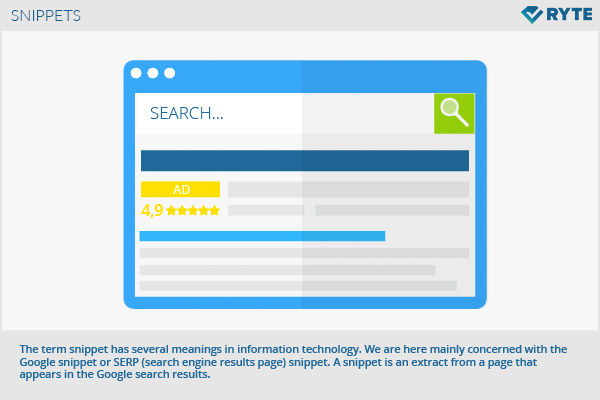Snippets
The term snippet has several meanings in information technology. We are here mainly concerned with the Google snippet or SERP (search engine results page) snippet. A snippet is a short summary of the content of a website that appears in the Google search results. Snippets are generated based on the search term and are presented as part of a search result list. Depending on the arrangement of of the search engine, a snippet becomes a rich snippet or "featured snippet." Often, google uses the Meta Description or the Meta Title of the landing page for the display of the snippet. The arrangement of the snippet can have an impact on the click rate.
Snippet components
A snippet is automatically generated by the search engine and mostly consists of stored metadata, title, description and the cached URL of a page. The URL is not necessarily displayed in full. If the URL is too long, Google cuts it off at a certain point. Title and description are limited to a certain number of characters. If the characters exceed the maximum pixels, Google may cut the snippet similar to the cache URL or automatically generate a snippet from the available content.
There is no guarantee that the existing metadata will be used by the search engine. Even when the length of the snippet conforms to the general SEO recommendations, Google might present a different snippet depending on the search query.
Currently, various types of snippets are provided. A snippet can contain, apart from the standard elements such as title, description and URL, further elements such as prices, event details and ratings stars. With many websites, a date in the form of a fresh tag is displayed.
Bold keywords in snippets
If a snippet contains the search terms that were typed in, these are highlighted in bold by Google. They are also called keywords in context (abbr.: KWIC). The bold style is used to enhance the user experience. This allows users to quickly identify whether their search terms appear on a page. A webmaster can benefit from bolding by accommodating more important keywords in the description, since snippets with highlighted terms will probably be clicked more often. However, meta descriptions have no direct influence on the ranking itself.
Rich snippets
In addition to standard snippets with the three basic elements, title, description and URL, there are a number of other snippet types such as rich snippets which may contain elements such as stars, links, pictures, videos, prices and more.
The information for generating rich snippets is stored by HTML markup in the source code of a page. This markup helps Google to recognize certain types of data to then display them in a useful way as part of rich snippets. Using Schema.org, a collection for rich snippets, you can very easily determine the important HTML tags for your website and structure the data accordingly.
The following data types are supported by Google:
- Reviews
- Products
- Organizations
- Recipes
- Events
- Music
- Prices
- Event details
Using the rich snippets testing tool (https://developers.google.com/structured-data/testing-tool/) you can test if a page fulfils the requirements for rich snippets in the SERPs. If a website is stored in the Google Search Console, the tool can show whether structured data is displayed correctly. Similarly, with the Search Console, the so-called "Data Highlighter" can be used for manually displaying structured data via the Frontend of a website.
Example for a rich snippet for the search “rich Snippet.” Author and data about Google+ circles are stored as micro data. However, this function is no longer used by Google.
There is essentially no guarantee that Google will generate a rich snippet on the basis of structured data.
Featured snippets
Google has been offering users "featured snippets" for a while. Featured snippets are search results which are displayed above the organic SERPs in their own box. Usually, featured snippets provide concrete answers to search queries which require a definition or can be answered with one sentence. Google continues to expand on this search function so that users often don't need to access a website to find out the answer to their search query.
Featured snippets shouldn't be confused with the Google One Box or the Knowledge Graph, which compiles varying information to a band, artist or situation. Featured Snippets are compiled with with data from algorithms on the basis of available content of a website.
Benefits of rich snippets
One benefit of rich snippets is increased user attention. Elements such as ratings, images or prices should generate user trust. This data serves as an eye catcher and stand out at first glance. Because rich snippets are significantly different from conventional search results, rich snippets can increase the click-through rate, (CTR) as visual attention is directed to the applicable search result.
Furthermore, it can be presumed that search engines positively evaluate certain content that is enriched with microdata. While this does not necessarily result in better rankings in the SERPs, they will at least get more attention from users. This then increases the CTR, which will in turn be positively evaluated by the search engines.
Web Links


